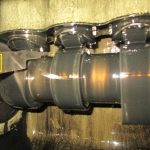Properties required of a crankcase oil which is to be used for a trunk piston main engine are the following:
Detergency
This keeps the crankcase, bearings and piston rings area clean from sludge and carbonaceous deposits. As the trunk piston engine suffers from a higher level of contamination into the lube oil system than a slow speed engine, then higher levels of detergency are important.
Dispersency
The dirt which is removed by the cleaning function is kept in suspension by the dispersency additives. These prevent the build up of sludge in the cooler regions of the engine.
Alkalinity
The level of this property is determined by the level of sulphur within the fuel oil. The additive reduces the corrosive effects which result when the products of combustion condense on the cooler surfaces.
Anti wear
This additive is provided to reduce the wear on the highly loaded areas of the engine, such as the camshaft and gearing areas.
Anti-emulsion
This property allows the oil to be cleaned in a purifier and allow any water contamination to be removed.
Stable Viscosity
This is ensured by the use of viscosity stabilisers or improvers which reduce the rate of fall in oil viscosity when the oil temperature increases.
Clean burning
As the oil is used to lubricate the piston ring pack, the oil should burn without leaving a residue.
Oil Sampling of Trunk Piston Engine
The engine should be running at normal load for at least one hour. The sampling point should be at the main LO entry point into the engine. The sampling point should be flushed through and when hot oil issues, a one litre container of oil should be drawn. The oil should be decanted into the sampling container, which is then sealed for analysis.
Shore Analysis Results of Lube Oil
Water in oil
Contamination source should be identified and cured. The water in the oil could be reduced by purifier, if the sump charge is large enough for a continuous purifier operation.
Falling alkalinity
Water contamination should be checked as when the water is removed then the alkalinity reserve will also fall. If water is not present then a small addition into the crankcase should be considered. The sulphur content of the fuel should be checked to ensure that the right grade of oil is being used.
Viscosity has fallen
Fuel or water contamination should be suspected. If fuel oil is found within the oil, heating the sample to smell the fuel contamination or testing for the flash point if this is available on-board. Source of the fuel contamination should be identified and cured. Note the diesel oil will reduce and fuel oil will increase the lube oil viscosity.
Carbon content has risen
This indicates that the carbon from the combustion process is contaminating the lube oil. Over the short term, regular filter cleaning is the only course of action open to the engineer, but over the long term the piston rings should be changed, and the fuel injection equipment overhauled.


